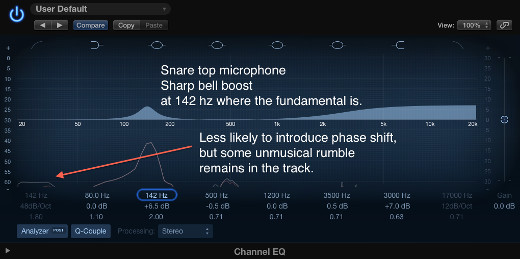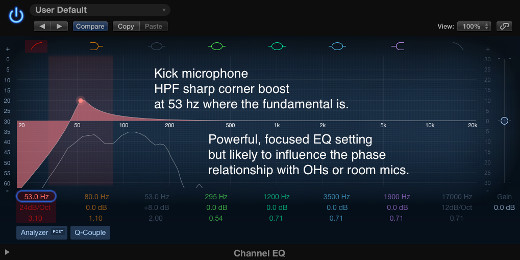Mix with Maury: EQing Drums to Enhance Low Frequency Transients
This is the second in a series by Andrew Maury. See his first article, “How and Why Distortion Can Replace the Need for EQ & Compression.”
Something I’ve started doing is EQing very sharp, carefully placed boosts to sub and/or bass frequencies on close-mic’d drum channels or samples. By finding the fundamental frequency and boosting, you can accentuate the drum’s natural character and bring up the perception of the transient.

Here’s how to enhance the meat of the beat. (Image supplied by Shutterstock).
This is a really great way to achieve a more focused low end in the mix because you’re EQing a very specific bit of information that is musically pertinent to the recording.
Zero in on the Sweet Spot
Every drum seems to have a fundamental note somewhere where it is most pronounced.
In the case of a kick drum, it is often found between 40 Hz and 100 Hz, and it’s the same with a floor tom. Rack toms tend to land somewhere between 60 Hz and 160 Hz, and snare drums tend to have a fundamental somewhere between 150 Hz and 250 Hz.
There are certainly overtones and resonances to be found above and below these center frequencies in a drum’s attack, but in there is a frequency spot where most of the “meat” resides. This frequency occurs because of the way the drum is tuned, and the physics of the drum’s inherent dimensions.
The better the drum is tuned, the more musical this resonance will be, and the easier it will be to find. A poorly tuned drum will sound papery and resonant in more than one place.
Hone in on Boosting the Fundamental
To better understand this technique at first, I advise you to involve an EQ that has a live spectrograph with a highly detailed resolution. Plugins such as Logic’s stock channel EQ or FabFilter Pro-Q can show you the live frequency response superimposed on the interface and help guide you where in the spectrum the transients are reading.
Now for a bit more advanced understanding of this technique… There are two ways you can hone in on boosting the fundamental. You can either use a bell shape OR a high pass filter (HPF) with a high Q, resulting in an exaggerated “corner.”
The advantage of the high pass filter approach is that it cuts out unnecessary rumble and focuses the low energy of the track into the spot you’re targeting. This is great practice for electronic drums, or individual samples placed on the timeline that stand on their own. It helps to buy you more precious headroom.
However, if you are mixing a live drum set where multiple microphones are involved (and the bleed between microphones is pertinent information), you have to be mindful of the fact that the HPF method introduces significantly more phase shift than a bell. This phase shift is a slight delay in the track, which will skew the phase relationship with the other microphones in the kit.
How the HPF Can Help
Lets look at EQing the snare as an example. In this example we have a snare top mic, snare bottom mic, and overhead mics to mostly consider when shaping our snare sound.
Often, the snare bottom and overhead microphones are recorded in phase with the snare top mic so that the low end is reinforced. If we put a HPF on the snare top mic and boost at the corner, it may reinforce the snare top mic’s low end while solo’d, but shift it out of phase with the overheads and snare bottom.
Reversing polarity of the snare bottom and overheads might reinforce the EQ move, or might not! If you find that the HPF is blurring the phase relationship, experiment with moving the frequency point around a little bit.
Sometimes there’s a sweet spot where the EQ boost and phase relationships all align. If it simply isn’t working, it’s safer to rely on the bell EQ method, because HPFs introduce more phase shift.
The chemistry of best phase relationship with bold HPF moves is subjective. It’s where your taste/skills have to take charge to decide what’s best for the track. There is no exact science to this, and every drum recording is different.
Let me close out this article by saying you can also EQ drums using ZERO scientific approach or calculated technique and just use your ears. Sometimes a “wrong” approach is so right…!
Andrew Maury is a producer/mixer based in Brooklyn, New York. Andrew immersed himself in the professional audio community and quickly garnered a reputation remixing as a member of the highly esteemed RAC (rac.fm) while, in parallel, touring the United States mixing front of house live sound for bands such as Ra Ra Riot, Givers, and Delicate Steve. Andrew’s first studio credit was assisting producer and Death Cab For Cutie guitarist Chris Walla on Tegan & Sara’s 2009 release, Sainthood. Andrew later co-produced and engineered Ra Ra Riot’s sophomore album, The Orchard, and has since worked on dozens of records for both indie and major label artists such as RAC, Panama Wedding, Milagres, Penguin Prison, Holychild, Kisses, and Superhumanoids.
Andrew will be working the remainder of 2014 producing/mixing forthcoming records for Panama Wedding, High Highs, Cruiser, and Strange Names.











Durchfall
September 17, 2014 at 2:47 pm (10 years ago)Awesome article. It’s something that I am always indecisive about in my approach. Question, in the bell shape approach, couldn’t you just adjust the Q more so that the frequency boost is more focused on that one particular frequency?
Andrew
September 19, 2014 at 1:01 am (10 years ago)definitely – should have mentioned that. adjusting the Q is part of honing in the detail of this technique.
saucyct
September 18, 2014 at 3:05 pm (10 years ago)When you say that a HPF introduces more phase issues, are you referring to the delay introduced by a plugin that would change the timing of both samples hitting the Master Fader? I’m wondering how else a HPF would introduce phase issues?
Andrew
September 19, 2014 at 1:09 am (10 years ago)no – i’m not talking about plugin latency. a tiny time delay is a basic byproduct of every HPF. this tiny delay is enough to skew how “in-phase” the signal is with other microphones in the kit, and has significant impact on the perception of the low end tightness. perhaps digital linear phase EQ’s that look ahead and make compensations to minimize phase shift work fine. but on the whole they’re CPU intensive and have always felt a little strange to me… I don’t have too much experience with them.
saucyct
September 19, 2014 at 9:29 am (10 years ago)Hi Andrew—This is good to know. I have never noticed any delay using the HPF on my preamps (non-digital, tube and solid-state), so now I am wondering if this delay is present in a pre vs. an EQ module, meaning, are pres able to “grab” sound with a HPF engaged without incurring the delay (shifting phase)? Also, to confirm, is the minor delay present in my DAW when using HPFs found in EQ plugins? I am wondering why I have never noticed this. Thanks for the info! —CT
Andrew
September 19, 2014 at 9:35 am (10 years ago)i’m no electrical engineer, but i can only assume the phase shift extists in both analog and digital HPFs. perhaps the slope of the HPF on your pre is gentle enough to reduce drastic phase shift. i *think* the steeper the filter, the more wacky shift you get. could also just be the luck of the draw… every mic’d kit has different characteristics of phase relationship and what works or doesnt work.
saucyct
September 19, 2014 at 10:21 am (10 years ago)Right on, I suppose there would always be the need for any device (digital or analog) to calculate what it is receiving and needs to do and that would introduce a pinch of delay. I found this bit from the mighty Fletcher:
“An analog ‘Hi-Pass Filter’ will indeed affect the internal ‘phase’ of a signal… whether the event is of a positive or negative nature will be up to you… often ‘snipping’ off the way bottom will have fewer adverse effects than leaving it there…
The nature of all analog equalization devices is to alter the phase relationships within the context of the signal… more often than not, it’s a good thing… though in some instances… it’s not a good thing at which point a different type/style of equalizer may be a good call.
Thanks for the learning!
CT
Weazie
September 22, 2014 at 9:28 pm (10 years ago)Great article, so glad I stopped by here and found this. Thanks!
The Synesthesian
December 11, 2014 at 10:08 pm (10 years ago)Great article! Quick question: In your bio, when you say you toured the united state “in parallel,” do you mean that you somehow bussed yourself to an auxiliary track/person and accomplished both tasks at once? If so, PLEASE SHOW ME HOW TO DO THIS!